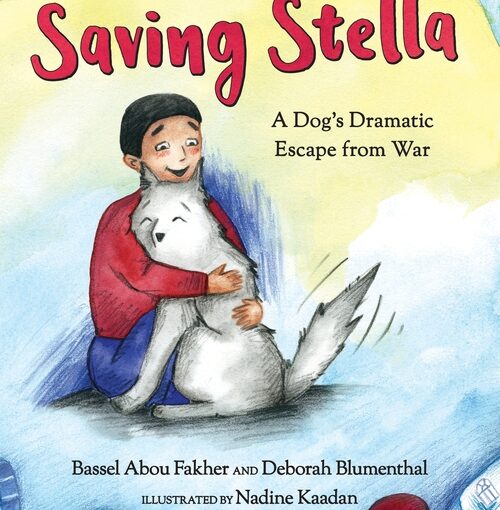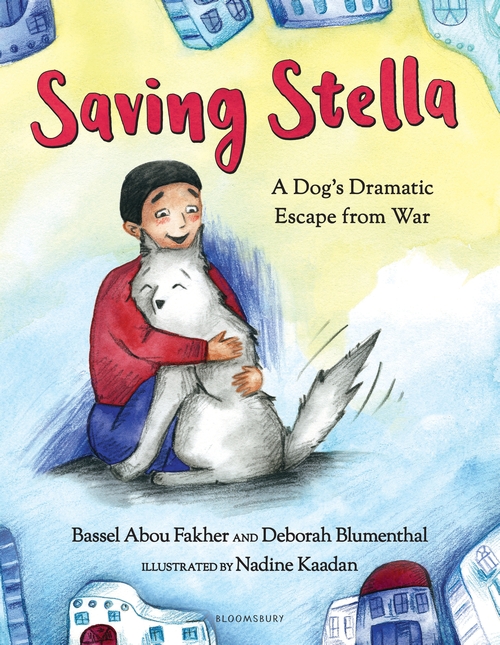There are books that kids want to read, books that parents/educators want them to read, and those books that sometimes straddle both camps. Saving Stella is one of those books that will keep a foot in each of those categories to some extent, due to its true story, soft visuals, and the always appealing element of a lovable dog.
The Syrian War is not a topic that one would have thought of as a good topic for an illustrated book. That’s where the unexpected addition of a dog makes this into a story that has universal appeal, as well as understanding. The fact that the story took place in 2015, which is recent history in anyone’s eyes helps make the story relevant.
Whenever we tell our nine-year-old a story he immediately peppers us with the question, “did this really happen?” Then, once he knows that it’s a true story he’ll try to determine its timeline. As the events in Saving Stella happened in his lifetime, it’s a period that he can identify with. This is not the time before cell phones or video games; it’s now, and to an extent, still happening.
Bassel was a 19-year-old living in Damascus, Syria and there were bombings, kidnappings, and violent the street on a daily basis. One of the few comforting aspects of his life was his music and his dog, Stella. Bassel’s parents lived there, but being a young man, he knew that the better future for him was to leave as soon as possible. All of this turmoil had been happening for years and he knew that he had to get out.
Making the journey from Syria to Europe on a raft would certainly be dangerous, and far too perilous to attempt with a dog. Stella was to stay with Bassel’s parents while he would make his new home in a safer place. Bassel successfully made his way to Europe and found a family who helped him make roots, but he still missed Stella.
Using the help of his friends and family still in Syria, Bassel hatched a plan to get Stella out of there and to his new home. It’s Stella’s story. Older readers will find that aspect the most amazing and surprising about Staving Stella. Out of the countless story threads from the Syrian War, this individual one puts the story, and its background through a lens that humanizes the Syrian people in a way that anyone can identify with.
How does one smuggle a dog out of war-torn Damascus and into Europe? It seems improbable and at times like a canine version of Monuments Men, albeit with a single directive. The plotting and scheming that needed to be accomplished in order to get Stella out of the country and back with Bassel is impressive. The fact that the journey was still dangerous for a man who had a dog in his car, illustrates the terror and uncertainty happening during the Syrian War. Even when Stella was en route to the airport in Beirut they were at risk of any one of the horrors that Bassel had successfully escaped.
The older, more adult questions like the appearance of just a dog being flown from Beirut to Belgium are acknowledged also. It’s a warzone and someone is just putting a dog onto a plane? The story has a happy ending, with Bassel and Stella being reunited and catching up on old times. The liner notes even have a photo of the two in their new apartment. Those notes also detail some of the deeper items that he had to go through in order for all of this to succeed.
Saving Stella is not a war journal. It’s the story about a young man who has escaped a war zone and the journey of his dog in joining him in his new life. The text is written in some simple and complex sentences that are on par for an illustrated book. Sometimes when the action or drama is higher than other times the sentences are shorter, which helps amp up the suspense.
This is not the first book that kids will reach for. The color choices in the book are almost exclusively blue or gray. That’s a subtle choice that allows the younger readers to know that something is troubled in their world. The color choices are further magnified when Stella and Bassel are playing in a park in Brussels. Those final two pages are loaded with red tulips, green trees, bright clothing, and smiling faces. The text, combined with these visuals will really help young readers see what a world of difference the two have come from.
Saving Stella is by Bassel Fakher and Deborah Blumenthal with illustrations by Nadine Kaadan and available on Bloomsbury Children’s Books.
There are affiliate links in this post.






 Facebook
Facebook Twitter
Twitter Flickr
Flickr GooglePlus
GooglePlus Youtube
Youtube